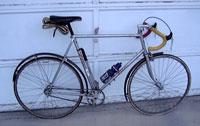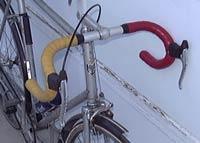The Way Of The
Fixie
By Mike Kallal
 |
A
winter beater that combines practicality with potential brutality
Photo: © Todd Archer
Winter's just got gone. Good thing, too. Your relationship with the stationary
trainer had become strained. You were been banned from riding rollers
in front of the TV since you used a Tour de France video segment to work
on 'top-end,' and went through a coffee table. Now, you know why it's
illegal to throw your hands in the air during a mass sprint finish.
That itch you're feeling is either the burning desire for Out-of-Doors
miles, or something fungal as a result of not having washed the bibshorts
for three workouts. But, look outside. That weather's still no place
for your titanium-encrusted crown jewel. And few of us are fortunate
to live near an indoor 250m. Options are dwindling. This may be the
time to consider fixed-gear road riding.
Fixed-gear training is a popular regimen in many cycling communities.
The tool is a respected special purpose bicycle, employed to improve
both technical skill and physical condition. They are often sold new,
built-up solely for their intended use. In the US however, fixed-gear
road riding remains an obscurity. "Fixed-gear trainer" is just one role
played by the American multi-purpose beater, a trophy of ruthless bikeswap
negotiation, sacked pro shop parts bins, and "Hey, if you're not going
to ride that…" appeals to friends.
A "fixie" is essentially the hybrid of a road frameset and a track
powertrain. Track framesets are sometimes adapted, but the high-and-forward
track riding position encourages climbing like farm animals eat: sloppy;
all over the place. A laid-back road configuration is more versatile,
and better accommodates long hours in the saddle.
The design concept is straightforward. Narrow the mechanical options
of the bike in order to broaden your ability to adapt. A fixie retains
none of the principal energy-sparing features of the contemporary road
rig:
- A single gear allows no alteration of the transmission for changes
in terrain. Ya cain't shift.
- The possibility of disengaging the powertrain from the wheels is
gone, also. There's no way to rely on inertia for the maintenance
of forward momentum. You ain't gonna coast.
Upside
 |
The
stark purity of the fixed-gear drivertrain
Photo: © Todd Archer
Fixed-gear proficiency has long been thought to enhance road bike ability.
By turning elevated RPMs on a fixed-gear trainer, conventional wisdom
suggests road-bike "spin" can be developed. So, having become adept at
the higher fixie cadence, you will manage the somewhat lower rate of turn
typical on the road bike with greater efficiency. Hhmmm…
Detractors of fixed-gear road training point to conflicting presumptions.
Detractors say fixed-gear theory implies that pedaling skill is apparently
unobtainable through thousands of kilometers of in-season road riding.
Or that, once acquired, the ability doesn't last the winter. However,
a buttery smooth road bike cadence can be had through a comparatively
short series of early season workouts on a fixed-gear trainer.
Critics dismiss the application of a fixed-gear trainer to improvement
of road bike technique as analogous to practicing on an ostrich as preparation
for riding a racehorse. Ideological opponents of the fixie advocate
a purist approach. To get good at riding a road bike, ride it.
Controversy aside, a fixed-gear trainer offers potentially useful
challenges. A fixie is harder to control than a road bike. More finesse
is required. Persistently turning crankarms force you to execute all
maneuvers while pedaling. There's no option of "three o'clock and nine
c'clock" freewheeling to set-up or execute a move. Holding a line through
a tight corner on a fixed-gear can become a gutter-scrubbing experience.
Pedal strike. It's not just for knuckleheads anymore. And the emergency
separation of tires and pavement is complicated when launch occurs with
cranks anywhere other than parallel to the ground .
Bunny-hopping a fixed-gear effectively is truly an art.
Forcing fitness
There's greater consensus on the value of fixed-gear road training
for physical condition. You have a limited range of capabilities. No
matter how well developed any of us may be, we're only human. Simply
configure the bike to emphasize your weaknesses, and it becomes a vehicle
for carrying them beyond their 'comfort zone.' It's a painful realm.
All levels of ability confront the costs of reabsorbing counterproductive
tensions generated by inefficient technique or fatigue. Fixed-gear road
training is not the exclusive province of a Category 'Ham & Egg' recreational
licensee.
A fixie will knock the slam out of the gamest gams.
The most severe deprivation of a fixed-gear trainer is likely the
absence of a variable transmission. Experience the scale of cadence
imposed during a fixed-gear road ride. You'll reconsider further trash-talking
of those quarrelsome integrated shifter levers. Of course, under or
overgearing for training effect is available on any derailleur-equipped
bicycle. It's a perceived benefit of a fixie that there are no alternatives.
An uphill where a lower gear would be most dearly appreciated often
provides for ascending at a max rate of turn approaching the espoir'
years.
This is an excellent way to build functionally specific strength.
After a difficult climb, many riders (admit it) won't pedal the downhill.
The requirement of doing so on a fixie further compounds your workload.
The fixie tao
of form
 |
Only
a front brake is necessary. Mis-matched tape is optional
Photo: © Todd Archer
The effects of over-spinning are more insidious, but cumulatively more
malicious than over-gearing. This is especially true in the case of direct-drive
powertrain. Under-gearing compels the mistakes of poor pedaling to be
both exaggerated and made more frequently. Direct-drive exploits errors
by making their consequences inescapable. You can sit up, 'sit-in,' or
slow down. It doesn't matter. If the wheels roll, the cranks turn. A fixie
will insist that you learn to spin smoothly, or soft-pedal home in aching
frustration.
Poor technique is often proportional to velocity. That's the root
objective though, isn't it: to go faster? Acceleration will ultimately
be met with disproportionately larger energy expenditures. You're going
faster, but the fatigue factor is rising even more rapidly due to decreasing
efficiency. On a fixed-gear trainer, the only way to maintain a quick
tempo is to become smoother. Pure form becomes the only 'fix' for an
addiction to speed.
Direct-drive compels you to actively manage continually moving crankarms.
This responsibility can be frightening on a downslope. Gravity provides
propulsion. You have the opportunity to passively experience an ultrahigh
turnover rate. Let the good times roll. The adventure of relying on
the universal force for effortless cadence is available only through
a fixed-gear descent. Nothing else offers so much RPM with so litte
exertion. You can focus on relaxing, and learn how it feels to get out
of their own way. It feels like flying in dreams.
If you are in search of blinding leg speed, a moderate topographic
decline will be necessary. A zen-like suspension of any sense of self-preservation
might not be a bad idea either. Fill your heart with a love of quickness,
let loose the binders, and transcend the higher spiritual plane of 200
RPM.
That's nearly 65 kph, in a 42/18, on 700x23 casings. An onboard computer
with max speed function may be desirable, if you're too preoccupied
to count and convert individual crankarm revolutions.
Feedback on fixed-gear performance will be immediate, and unmistakable.
Bouncing in the saddle is a reliable indication you're no longer 'spinning
circles.' The bike will begin to behave more like a high-frequency pogo-stick.
Throttle back before things get any more ballistic and compromise handling.
Spinning at a cadence beyond your wildest expectation can open the soul.
Turning cranks at a rate beyond clear command can open the skull.
At a standstill, direct-drive can actually help you stay upright,
sometimes motionlessly. Like nuclear weapons however, it's a point of
subtlety to maintain certain resources while rarely demonstrating them.
Friends don't let friends trackstand in traffic.
Focus
Fixed-gear road riding will test your concentration as well. Lapse
of focus will be penalized immediately. Consequences are potentially
dire.
A fixed-gear trainer is a Pedaling Instructor who will demand unqualified
attention. Should you forget to 'keep up' with the crankarms, you may
merely have a foot kicked over the top of the stroke. A less forgiving
mentor might elect to vault you upward off the saddle. You could even
be tossed forward over the bars.
A fixed-gear trainer can be a brutish riding companion, but one who's
a hell of a lot of fun. Most of us know their type. Save debate over
the merits of the fixie as an instrument of technical facilitation for
the post-ride coffee shop forum. Dialogue is much less likely to become
inflammatory after a lengthy bout of fixed-gear ass-whipping.
Will polished form on a fixed-gear road trainer carry-over to more
fluid pedaling on the fully outfitted road rig, or higher 'top end'
in a Chariot Race? Maybe. There are reasonable arguments on all sides.
Sadly, precious little of what we bicyclists do impresses the cold,
calculating eye of Reason. Moot point. Just ride.
A fixed-gear road trainer possesses unique attributes. The experiences
a fixie can offer are unattainable on any other kind of bike. These
distinct characteristics allow a kind of riding that's enjoyable as
an end in itself. Ride Well.
|